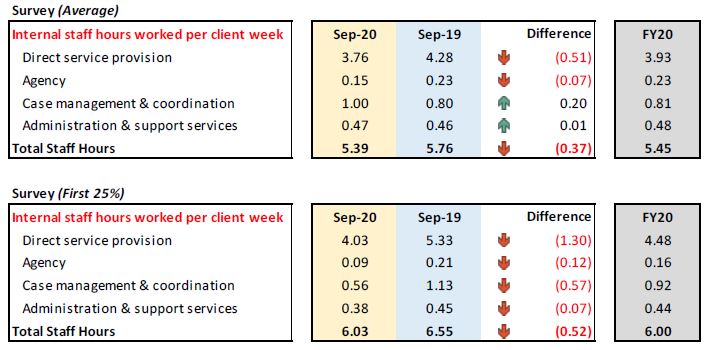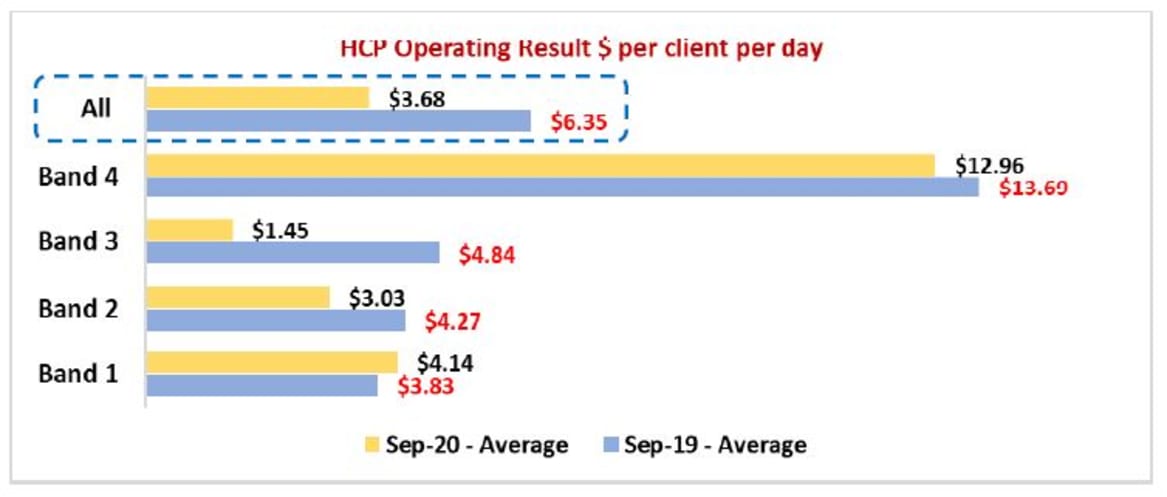Home care providers did not fare much better in the survey results.
The findings show that revenue per client per day (pcpd) average for participants declined by 4.5% (being $3.28 pcpd), while the average operating profit per client day significantly decreased by $2.67 pcpd to $3.68 pcpd from $6.35 in the previous September quarter.
“It is a slight improvement on the FY20 results of $3.59 pcpd but given that the September quarter is usually the most profitable, the results are less than what might be expected,” the report states.
First 25% sees bigger % drop in revenue
The First 25% – which represents the quartile of programs with the highest NPBT result – also took a hit, with average revenue per client decreasing by 6.9% to $6.41pcpd, with the average operating profit falling by $1.25 pcpd to $20.12 pcpd.
StewartBrown speculates that, given current circumstances with COVID and the increased levels of competition, providers may have been reluctant to make adjustments to their pricing structures on 1 July 2020 – even though their costs would have gone up.
“Please note that that the improved performance was not as a result of increased revenue, but due to reduced costs, and particularly staff costs (and resultant staffing hours). Whether this is sustainable is open to conjecture,” they state.
$1.25 billion in unspent funds
Unspent funds also continue to be a sticking point.
While revenue utilisation increased by 2.0% to 85.5%, the average unspent funds per client has increased by $1,856 per client to an average of $9,151 – that’s around $1.25 billion in funding that is not being utilised.
For the First 25%, the average was $11,186.
StewartBrown notes this issue will be largely be addressed by the movement to the new payments in arrears for home care providers, scheduled to start next week on 1 February.
“However, it will not alleviate the overall level of unspent funds in the system,” they add.
Staff hours falling to an average of five hours
The biggest drop however was to staff hours – an issue that was highlighted by StewartBrown Senior Partner Grant Corderoy’s data that showed the number of care hours provided to Level 4 package recipients has dropped by 50% from about 12 hours to 8.36 hours in the last 10 years.

The survey shows staff hours per client per week were reduced by 0.37 hours from 5.76 hours in September 2019 to an average of 5.39 hours per week in September 2020.
For the First 25% of operators, staff hours per client per week dropped by 2.06 hours to an average of 5.06 hours per week.
StewartBrown states that care hours have declined between FY17 and FY19 which they say may be partly due to lower available package revenue as a result of the increased unspent funds, but is “also likely due to driving lower costs to improve profitability”.
“Agency hours have declined and case management & coordination hours have increased. Administration & support services staff hours have remained fairly stable across the Survey from Sep-19 to Sep-20,” they add.
Care needs need to be better assessed
You must ask the question: is this a sustainable way to run a business?
And to provide the services that older Australians are entitled to receive?
The answer is no – and it’s a question that the Government will need to solve.
With the Royal Commission’s Final Report now just a month away – and likely to advocate for more people to received aged care services at home – the sector’s future sustainability depends on a resolution.










